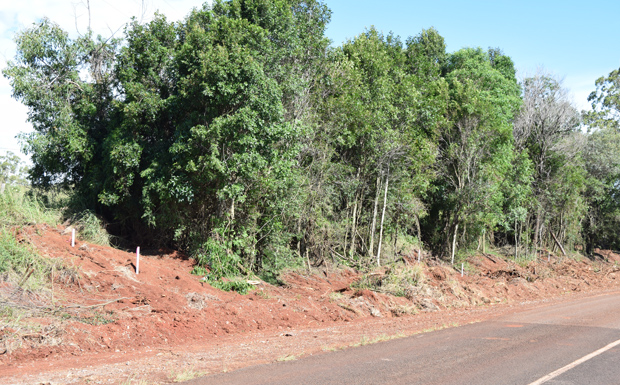
February 4, 2016
The discovery of 11 rare trees – which has delayed the re-alignment of a dangerous corner on the Tingoora Chelmsford Road – has South Burnett mayor Wayne Kratzmann seeing red.
In his report to Wednesday’s Council meeting, Cr Damien Tessmann referred to the fact that “the local ecology” in the area of the roadworks needed further investigation. This had delayed the start of the project, which had been due to begin last week.
“By ‘local ecology’ are we talking about plants again?” Mayor Kratzmann asked.
“This Council, in my opinion, gets a lot of unwarranted criticism about us spending a certain amount of money.
“It’s been covered in the press. I urge the press today to write the story about what it costs the Council regarding ecology on plants.
“I would like to know what it cost us on the overtaking lanes at Wooroolin where we had to identify some plants.
“Now, I live in a National Park. I’m keen for the preservation of our trees. But simply, in 2016, when the ratepayers’ dollar is hard enough to get in, it’s so hard to spend money with the cutbacks, (we can’t afford) to have additional costs because of ecology of plants.”
Mayor Kratzmann said he had a feeling this subject could be coming up at the Council meeting after he drove along the road on Tuesday.
“I shudder when I see little pink ties (which mark protected plants) on the side of the road,” he said.
“I don’t know what this is going to cost us but whatever it’s going to cost us we can’t afford it. Council needs to take this up with other councils as well.
“Whether those plants were there or not would not make any difference to our community, to our future, to the future of Tingoora or Wooroolin or the South Burnett.
“And no one even knew they were there before we went in and did the work!”
Mayor Kratzmann said it was a dangerous corner where people could be killed.
“Council has had the desire to fix that and now that work has been delayed because we found local ecology on the side of the road,” he said.
“Councils can’t do this any more and the State Government needs to be told that.
“This is not about being opposite to the Greens. I support emission control etc etc.
“This is just simply crazy and simply a waste of Council and ratepayers’ money that we cannot afford.”
Cr Ros Heit said the closure of the road was also very inconvenient for local peanut farmers during their harvest.
She said Council had been trying to work with the farmers, but because of this delay, they would now be travelling an extra 10km with every load of peanuts.
* * *
southburnett.com.au understands that Council initially located a single Acacia tingoorensis along the route of the proposed road realignment but it has now identified 10 Callitris baileyi
According to the Atlas of Australia, A. tingoorensis is a species of wattle native only to Queensland. It is classified as “significant” and “vulnerable” and is found only near Kingaroy and in the Ingham area of north-eastern Queensland.
C. baileyi is better known as Bailey’s Cypress Pine. It is found sporadically between the NSW border to Goomeri and west to the Bunya Mountains. A small population also exists in north-eastern NSW. In NSW, it is classified as “threatened” and in Queensland as “near threatened”.
























Mr Mayor, living in a national park doesn’t make you an environmentally conscious person. Maybe do some research first before approving infrastructure in vulnerable areas. These trees are very rare and found only in three small pockets of Australia.
All SBRC councilors and local residents would be familiar with Duboisia [corkwood] and the development of this industry and its value to this regain. Whether these particular stands of trees could hold some value in the future is simply unknown. The Wooroolin overtaking lane, being a Main Roads project, would have been funded through State or Federal government funding and contracted out to Council for construction.
Scuttlebutt also suggests that road construction crews are to be reduced through natural attrition, staff seeking alternate employment opportunities and retirement with staff not being replaced. If true, this would suggest Council’s overly ambitious spending program has seriously depleted funds for road repair and construction. The cost of discretionary spending would be of interest to the general public and its cost impact on basic services and rates.
The Threatened Species fact sheet series has been produced by Council to raise awareness amongst residents and visitors about threatened plant species occurring in the South Burnett Region. These plants are listed as critically endangered, endangered, vulnerable or near threatened under either the Queensland Nature Conservation Act 1992 or the Environment Protection and Biodiversity Conservation Act 1999 (Commonwealth).
The locations of these plants within the South Burnett road network and Council managed reserves have been mapped and an ecological report has been developed for each species. This will allow Council to better manage and protect these plants from the risk of extinction, through measures such as control of environmental and declared weeds, better fire management and restoration works in the priority areas containing these plants.
http://www.southburnett.qld.gov.au/documents/41153986/41179777/Acacia%20tingoorensis